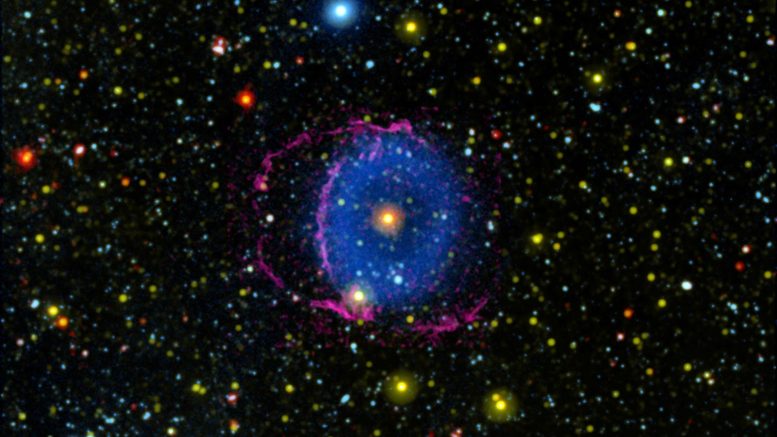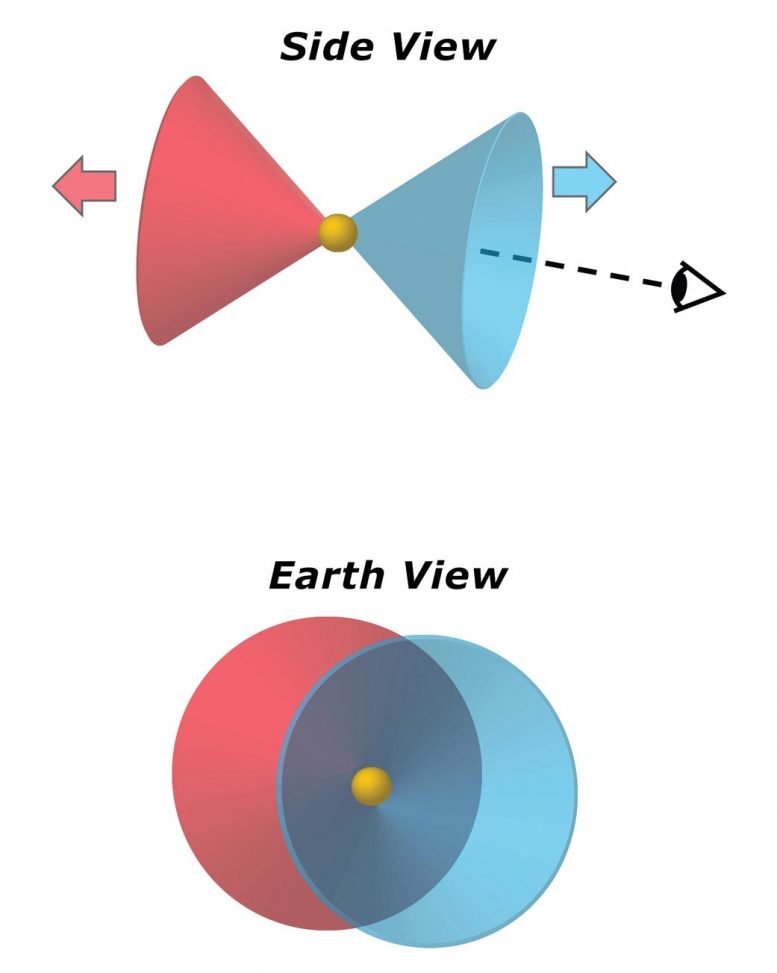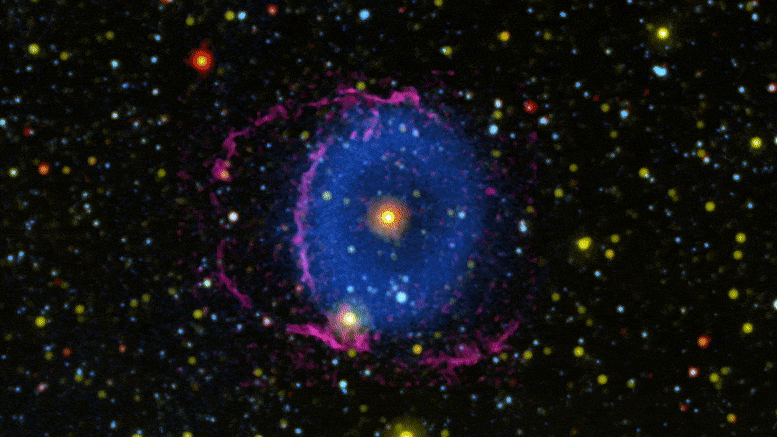The Blue Ring Nebula, which puzzled scientists for over a decade, appears to be the latest known example of two stars fused into one.
In 2004, scientists started using NASAThe space-based Galaxy Evolution Explorer (GALEX) discovered an object as they had never seen it before in ours Milky Way Galaxy: a large, faint lump of gas with a star in the middle. In the GALEX images, the blob appeared blue – although it does not emit any visible light to the human eye – and subsequent observations revealed a thick ring structure in it. So the team called it the Blue Ring Nebula. For the next 16 years, they studied it with several Earth- and space-based telescopes, but the more they learned, the more mysterious it seemed.
A new study published online November 18 in the journal Nature may have cracked the case. By applying cutting-edge theoretical models to the amount of data collected for this object, the authors determine that the nebula – a gas cloud in space – is likely made up of debris from two stars that collided and merged into a single star.

The Blue Ring Nebula consists of two expanding cones of gas that are ejected into space by a star fusion. When the gas cools, it forms hydrogen molecules that collide with particles in interstellar space, causing them to emit distant ultraviolet light. Invisible to the human eye, it is shown here as blue. Photo credit: NASA / JPL-Caltech / M. Seibert (Carnegie Institution for Science) / K. Hoadley (Caltech) / GALEX-Team
While merged star systems are believed to be quite common, it is next to impossible to study them immediately after they are formed, as they are obscured by debris that sets off the collision. Once the debris is gone – at least hundreds of thousands of years later – it is difficult to identify because it resembles unfused stars. The Blue Ring Nebula seems to be the missing link: astronomers see the star system only a few thousand years after the merger, when there is still ample evidence of union. It appears to be the first known example of a merged star system at this point in time.
GALEX operated between 2003 and 2013 and was administered by NASA’s Jet Propulsion Laboratory in Southern California. It was developed to study the history of star formation in most of the universe by counting young star populations in other galaxies. For this purpose, the mission observed both near UV light (wavelengths slightly shorter than visible light) and far UV. Most of the objects seen by GALEX emitted both near UV (shown as yellow in GALEX images) and far UV (shown as blue), but the Blue Ring Nebula stood out because it only emitted distant UV light.
The size of the object was similar to that of a supernova remnant that forms when a massive star runs out of fuel and explodes, or a planetary nebula, the inflated remains of a star the size of our sun. But the Blue Ring Nebula had a living star in the middle. In addition, supernova remnants and planetary nebulae emit multiple wavelengths of light outside of the UV range, while further research showed that the Blue Ring Nebula did not.

The Blue Ring Nebula consists of two hollow, cone-shaped debris clouds that move in opposite directions away from the central star. The base of a cone moves almost directly to the earth. As a result, astronomers looking at the nebula see two circles that partially overlap. Photo credit: Mark Seibert
Phantom Planet
In 2006, the GALEX team examined the nebula with the 5.1-meter Hale telescope at the Palomar Observatory in San Diego County, California, and then with the even more powerful 10-meter telescopes at the WM Keck Observatory in Hawaii. They found evidence of a shock wave in the nebula, suggesting that the gas that makes up the Blue Ring Nebula was actually ejected by a violent event around the central star. Keck data also indicated that the star was pulling a large amount of material onto its surface. But where did the material come from?
“For a long time we thought that there might be a planet several times the size of Jupiter Getting torn apart by the star and throwing all the gas out of the system, ”said Mark Seibert, astrophysicist at Carnegie Institution for Science and member of the GALEX team at Caltech that manages the system JPL.
But the team wanted more data. In 2012, the GALEX team used the first full sky survey by NASA’s WISE (Wide Field Infrared Survey Explorer), a space telescope that examined the sky in infrared light, a disk of dust orbiting closely around the star. (WISE was reactivated as a NEOWISE asteroid hunting mission in 2013.) Archival data from three other infrared observatories, including NASA’s Spitzer Space Telescope, also discovered the disk. The result didn’t rule out a planet orbiting the star as well, but eventually the team would show that the disk and material ejected into space came from something larger than itself a giant planet. In 2017, the Hobby Eberly Telescope’s Habitable Zone Planet Finder in Texas confirmed that no compact object orbited the star.
More than a decade after the Blue Ring Nebula was discovered, the team had collected data on the system from four space telescopes, four ground-based telescopes, and historical observations of the star dating back to 1895 (to look for changes in its brightness) and with the help of citizen scientists by the American Association of Variable Star Observers (AAVSO). But an explanation for what had created the mist still escaped them.
The Blue Ring Nebula consists of two expanding cones of debris. The base of a cone moves towards the earth. Both bases are outlined in magenta and show shock waves that occur when the debris rushes through space. Blue stands for material behind the shock wave and is only visible where the cones overlap. Photo credit: NASA / JPL-Caltech / R. Injured
Stellar sleuthing
When Keri Hoadley was working with the GALEX science team in 2017, “the group hit some kind of wall with the Blue Ring Nebula,” she said. But Hoadley, an astrophysicist at Caltech, was intrigued by the object and its bizarre features, and so she accepted the challenge of solving the puzzle. It seemed likely that the solution would come not from further observations of the system, but from cutting edge theories that might make sense from the existing data. Chris Martin, Principal Investigator for GALEX at Caltech, reached out to Brian Metzger from Columbia University for help.
As a theoretical astrophysicist, Metzger creates mathematical and computational models of cosmic phenomena that can be used to predict how these phenomena will look and behave. He specializes in cosmic fusions – collisions between different objects, whether planets and stars or two black holes. With Metzger on board and Hoadley in charge of the work, things went quickly.
“Brian couldn’t just explain the data we were seeing. He essentially predicted what we’d seen before he saw it, ”said Hoadley. “He would say, ‘If this is a great fusion then you should see X’ and it was like, ‘Yes! We see that! ‘”
The team concluded that the nebula was the product of a relatively fresh stellar fusion that likely occurred between a star similar to our Sun and another star only about one-tenth that size (or about 100 times the mass of Jupiter ) scam. Towards the end of its life, the sun-like star swelled and crept closer to its companion. Eventually the smaller star fell in a downward spiral towards its larger companion. On the way, the larger star tore the smaller star apart and wrapped itself in a ring of debris before completely swallowing the smaller star.
This was the violent event that led to the formation of the Blue Ring Nebula. The merger hurled a cloud of hot debris into space, which was split in two by the gas disk. This created two cone-shaped debris clouds, the base of which moved in opposite directions away from the star and broadened on their way out. The base of one cone comes almost straight to the earth and the other almost straight away. They are too faint to be seen on their own, but the area where the cones overlap (when viewed from Earth) forms the observed central blue ring GALEX.
Millennia passed. The expanding cloud of debris cooled, forming molecules and dust, including hydrogen molecules, that collided with the interstellar medium, the sparse collection of atoms and energetic particles that fill the space between stars. The collisions excited the hydrogen molecules and made them radiate in a certain wavelength of distant UV light. Over time, the glow became just bright enough for GALEX to see.
Star mergers can occur in our Milky Way Galaxy up to every 10 years, which means that a sizeable population of the stars we see in the sky may have been two.
“We are seeing many two-star systems that might one day merge, and we believe we have identified stars that merged perhaps millions of years ago. However, we have almost no data on what happens in between, ”said Metzger. “We believe our galaxy is likely to have many young remnants of star fusions, and the Blue Ring Nebula could show us what they look like so we can identify more of them.”
While this is likely the conclusion of a 16 year old riddle, it could also mark the beginning of a new chapter in the study of star fusions.
“It’s amazing that GALEX was able to find this really faint object that we weren’t looking for, but that turns out to be something really interesting to astronomers,” said Seibert. “It just repeats that when you look at the universe in a new wavelength or in a new way, you find things that you never imagined.”
JPL, a division of Caltech, led the GALEX mission for NASA’s Science Mission Directorate. The mission was developed by NASA’s Goddard Space Flight Center in Greenbelt, Maryland, as part of the Explorers Program. JPL also directed the Spitzer and WISE missions as well as the NEOWISE mission.



